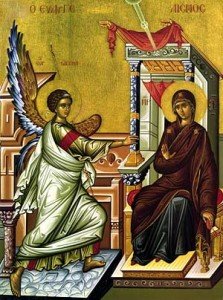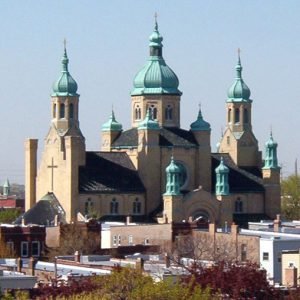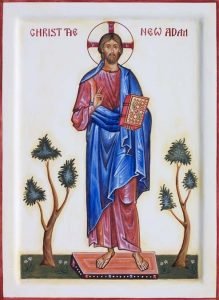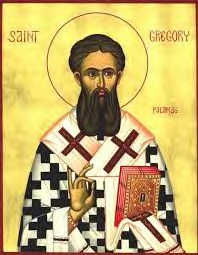As many know, our Church embraces an Eastern Christian tradition that is ancient. SS Cyril and Methodius came to the Slavic area, now known as Bulgaria, and brought with them the Christian traditions of the Byzantine Church, the Church as it found expression in Constantinople, present day Istanbul. Rusyns embraced this tradition. The center that supported the development of Christianity in the area now know as Ukraine was Kyiv. That is our tradition. There are, according to one author, two icons that are essential to understanding ourselves who worship in this Kyvian tradition and are members of the Ukrainian Greek-Catholic Church. Those two icons are the Annunciation, which relates the Incarnation of God as Jesus and Mary of the Sign or the Oranta.
 The Annunciation icon is traditionally placed on the Royal Doors of the iconastasis. It is the mystery which opens the Kingdom of God to us. The real significance of the encounter of Mary with the Archangel Gabriel is that she is asked to place her trust in God. It was truly a very thoughtful act. It was a challenge to her humanity which she met with maturity. Intelligent and personal commitment is what was expected of her and is also expected of each one of us. Our entire relationship to God has to come out of the precept that an intelligent being makes thoughtful decisions on all major aspects of human existence. Anything less than that does not befit our Creator and His Holy Wisdom. Western Christian tradition has a tendency to overplay the Mother of God’s virginity and in doing so distorts the essence of humanity in general and womanhood in particular. In Western Christianity, Mary is pictured alone. In Eastern Christianity she is never pictured without Christ.
The Annunciation icon is traditionally placed on the Royal Doors of the iconastasis. It is the mystery which opens the Kingdom of God to us. The real significance of the encounter of Mary with the Archangel Gabriel is that she is asked to place her trust in God. It was truly a very thoughtful act. It was a challenge to her humanity which she met with maturity. Intelligent and personal commitment is what was expected of her and is also expected of each one of us. Our entire relationship to God has to come out of the precept that an intelligent being makes thoughtful decisions on all major aspects of human existence. Anything less than that does not befit our Creator and His Holy Wisdom. Western Christian tradition has a tendency to overplay the Mother of God’s virginity and in doing so distorts the essence of humanity in general and womanhood in particular. In Western Christianity, Mary is pictured alone. In Eastern Christianity she is never pictured without Christ.
At a recent ecumenical Marian conference, Fr. Robert F. Taft, S.J., the theologian and major author on Eastern Christian worship, decried the Western reductionist approach to Mary. He thinks it is endemic to Mediterranean Catholic culture resulting in “machismo” only to be followed by more distortions and even abuse. Defining the Mother of God and her womanhood in the sexual context by glorifying female chastity ignores her intelligence. In the Western world her immaculate status seems to signify only abstention from sex, rather than expressing the sublime doctrine of the divine origin of the Only-begotten Son and Word of God, and the saving action of the Holy Spirit in Christ’s absolutely divine “Incarnation” to which the Mother of God agreed with great personal discernment.
The Eastern approach seems to highlight the fact that salvation is a cooperative act between God and man. It takes a person to commit themselves to the actualization of their potential to grow in their likeness of God as made manifest in the Person of Jesus.

 What does it mean to be in the image of God? Often enough, we find the Fathers giving an answer in terms of human qualities, and these turn out to be qualities of the soul. The “according to the image”, says John Damascene, is truly manifest in intelligence and free will. Being in the image means being a rational, or intelligent, being with free will. Sometimes the answer is more complex. Athanasius, for instance, talks about God’s creating us and our being ‘given something more’:
What does it mean to be in the image of God? Often enough, we find the Fathers giving an answer in terms of human qualities, and these turn out to be qualities of the soul. The “according to the image”, says John Damascene, is truly manifest in intelligence and free will. Being in the image means being a rational, or intelligent, being with free will. Sometimes the answer is more complex. Athanasius, for instance, talks about God’s creating us and our being ‘given something more’: This weekend our readings are taken from Paul’s letter to the Romans and Matthew’s Gospel. Paul states at the end of Chapter 6, “the gift of God is eternal life in Christ Jesus our Lord.” Think about this! God became man in the Person of Jesus, in order to reveal to us our true nature as human beings. If, of course, we don’t believe this to be true, we cannot understand this or be disposed to experience this. This is one reason why Paul exhorts the Romans and us to believe in the Person of Jesus, the Christ. God revealed the meaning and purpose of life through the Person of Jesus.
This weekend our readings are taken from Paul’s letter to the Romans and Matthew’s Gospel. Paul states at the end of Chapter 6, “the gift of God is eternal life in Christ Jesus our Lord.” Think about this! God became man in the Person of Jesus, in order to reveal to us our true nature as human beings. If, of course, we don’t believe this to be true, we cannot understand this or be disposed to experience this. This is one reason why Paul exhorts the Romans and us to believe in the Person of Jesus, the Christ. God revealed the meaning and purpose of life through the Person of Jesus. As I have shared, the Ukrainian Greek-Catholic Church came into union with the Catholic Church of Rome through the Union of Brest-Litovsk. A Papal Bull was issued by the pope that recites the events which led to the union, the arrival of six Ruthenian bishops at Rome, their abjuration, and the concessions made by the Roman Church. The Ruthenians were to retain their own rite, saving such customs as were opposed to the purity of Catholic doctrine and incompatible with the communion of the Roman Church. From the 9th century, the “land of the Rus”, which was known later as Kievan Rus, was known in Western Europe by a variety of names. From the 12th century Rus was usually known in Western Europe by the Latinised name Ruthenia. In their broadest usage, Ruthenians were used to refer to peoples now called Belarusians, Russians, and Ukrainians.
As I have shared, the Ukrainian Greek-Catholic Church came into union with the Catholic Church of Rome through the Union of Brest-Litovsk. A Papal Bull was issued by the pope that recites the events which led to the union, the arrival of six Ruthenian bishops at Rome, their abjuration, and the concessions made by the Roman Church. The Ruthenians were to retain their own rite, saving such customs as were opposed to the purity of Catholic doctrine and incompatible with the communion of the Roman Church. From the 9th century, the “land of the Rus”, which was known later as Kievan Rus, was known in Western Europe by a variety of names. From the 12th century Rus was usually known in Western Europe by the Latinised name Ruthenia. In their broadest usage, Ruthenians were used to refer to peoples now called Belarusians, Russians, and Ukrainians. The Nicaean Creed states our belief the Jesus Christ is eternally begotten of the Father before all ages and not created. It also describes Him in the philosophical terms and poetic imagery that the one Lord Jesus Christ is Light of Light, very God of very God. And being of one essence with the Father. This places Jesus as equal to the Father as God.
The Nicaean Creed states our belief the Jesus Christ is eternally begotten of the Father before all ages and not created. It also describes Him in the philosophical terms and poetic imagery that the one Lord Jesus Christ is Light of Light, very God of very God. And being of one essence with the Father. This places Jesus as equal to the Father as God. A fascinating instance of how this exclusive position was attained by the four Gospels that are a part of the Canon of the New Testament (NT), is presented in the story of Serapion, bishop of Antioch (ca 190 CE). Serapion discovered that in Rhossus people read the Gospel of Peter, but he forbade them to use it because he found Docetist heresy in it. This story illustrates two things: First, the public reading of the Gospels, particularly in the Liturgy, was one of the factors that won acceptance for them in the Church, and church authorities became very sensitive if a gospel not known to them was being read. Second, the use of apocryphal gospels by heretics was a factor in narrowing the canon to four gospels. Also, the attitude of the archheretic Marcion in accepting only Luke, may have been influential in causing the Church to preserve the four Gospels. From ca 200 the four Gospels had an assured place in the Greek and Western churches. As Oregin puts it, there are four Gospels, “which are undeniably authentic in the Church of God on earth.” The Syrian church, however, preferred the use of the Diatessaron in the 3rd and 4th centuries, adopting the four Gospels only in the 5th century.
A fascinating instance of how this exclusive position was attained by the four Gospels that are a part of the Canon of the New Testament (NT), is presented in the story of Serapion, bishop of Antioch (ca 190 CE). Serapion discovered that in Rhossus people read the Gospel of Peter, but he forbade them to use it because he found Docetist heresy in it. This story illustrates two things: First, the public reading of the Gospels, particularly in the Liturgy, was one of the factors that won acceptance for them in the Church, and church authorities became very sensitive if a gospel not known to them was being read. Second, the use of apocryphal gospels by heretics was a factor in narrowing the canon to four gospels. Also, the attitude of the archheretic Marcion in accepting only Luke, may have been influential in causing the Church to preserve the four Gospels. From ca 200 the four Gospels had an assured place in the Greek and Western churches. As Oregin puts it, there are four Gospels, “which are undeniably authentic in the Church of God on earth.” The Syrian church, however, preferred the use of the Diatessaron in the 3rd and 4th centuries, adopting the four Gospels only in the 5th century. Gregory states about the Persons of God: There was never a time when there was not a Father, A Son and a Holy Spirit. The Father has always been unbegotten, the Son always begotten and the Spirit always proceeding from the Father together with the Son. Gregory describes this unique relationship of love using the special technical theological vocabulary of unbegotten, begotten, and proceeding and states that these processes are beyond the sphere of time and above the grasp of reason.
Gregory states about the Persons of God: There was never a time when there was not a Father, A Son and a Holy Spirit. The Father has always been unbegotten, the Son always begotten and the Spirit always proceeding from the Father together with the Son. Gregory describes this unique relationship of love using the special technical theological vocabulary of unbegotten, begotten, and proceeding and states that these processes are beyond the sphere of time and above the grasp of reason.